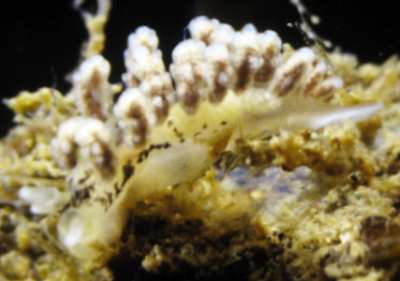
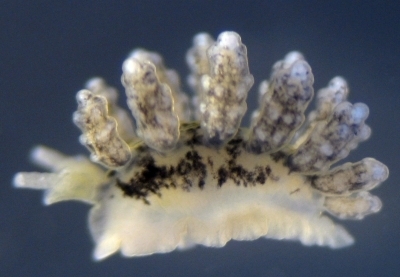
Doto kya
Marcus, 1961
Order: NUDIBRANCHIA
Suborder: DENDRONOTINA
Family: Dotidae
DISTRIBUTION
Distribution: Bamfield, Vancouver Island, British Columbia (Millen 1983) to Punta Cabras, Baja California, Mexico (Hamann 1981)
PHOTO
Upper: North Cove, Cape Arago, Oregon, USA. Pacific coast. Intertidal. Length: 10 mm. May 1980. Rocky shore. Photographer: Jeff Goddard. Lower: Scott Creek, Santa Cruz County, Intertidal, California, USA, Pacific, 12 June 2006, Rocky shore. Length: 4 mm. Photographer: Jeff Goddard.
Along with Doto columbiana, Doto kya is one of two species of Doto known from the cold temperate waters of the northeastern Pacific Ocean with dark pigmentation on the body, head, rhinophore sheaths and cerata. The brown to black pigmentation is darker and more concentrated than in Doto columbiana and occurs on the sides of the body, especially anteriorly [Upper photo], but not on the sides of the foot as in Doto columbiana. This difference in pigmentation persists in specimens preserved in ethanol [Lower photo] and can be used to distinguish preserved Doto kya from Doto columbiana. There are 6 to 9 (usually 7 to 8) pairs of cerata with ovoid, upward-pointing tubercles. Varying amounts of dark, subcutaneous pigmentation occur between the tubercles, and when dense, may form rough rings around the tubercles. The ground color of the body is translucent white, and the rhinophores and their sheaths contain opaque white, spherical bodies.
Adults measure up to about 10 mm long and are usually found with their egg masses associated with the basal stolons of Plumularia spp., often growing on perennial brown algae, such as Cystoseira osmundacea. Like Doto columbiana, the larvae of Doto kya are planktotrophic (Goddard 1996, 2005), and the adults can be locally abundant.
Although Doto kya was described from a single preserved specimen (supplemented with the collector's notes on the living specimen), Marcus' description and illustrations of the specimen, especially the pigmentation on the body, are unequivocal. Doto kya is depicted in Behrens (1991) and Behrens and Hermosillo (2005) under both Doto kya and Doto columbiana.
-
Behrens, D.W. 1991. Pacific Coast Nudibranchs. Sea Challengers, Monterey, California. 107 pp.
-
Behrens, D.W. and Hermosillo, A. 2005. Eastern Pacific Nudibranchs. Sea Challengers, Monterey, California. 137 pp.
-
Hamann, J. 1981. Range extensions of northeast Pacific opisthobranchs. Opisthobranch Newsletter, 13: 21.
-
Marcus, E. 1961. Opisthobranch mollusks from California. The Veliger, 3(Supplement 1): 1-85.
-
Goddard, J.H.R. 1996. Lecithotrophic development in Doto amyra (Nudibranchia: Dendronotacea), with a review of developmental mode in the genus. The Veliger, 39: 43-54.
-
Goddard J.H.R. 2005 (for 2004). Developmental mode in opisthobranchs molluscs from the northeast Pacific Ocean: feeding in a sea of plenty. Canadian Journal of Zoology, 82: 1954-1968.
-
Millen, S.V. 1983. Range extensions of opisthobranchs in the northeastern Pacific. The Veliger, 25: 383-386.
Goddard, J.H.R., 2006 (February 9) Doto kya Marcus, 1961. [In] Sea Slug Forum. Australian Museum, Sydney. Available from http://www.seaslugforum.net/find/dotokya
Related messages
Doto kya from central California
August 31, 2006
From: Jeff Goddard
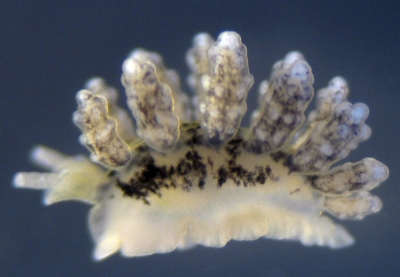
Hi Bill,
Here is an image of Doto kya (in Magnesium chloride). In contrast to the sympatric D. columbiana, the pigment on the body of D. kya is darker and does not occur on the foot. Compared to my earlier images, this one should better represent this species on its factsheet.
Locality: Scott Creek, Santa Cruz County, Intertidal, California, USA, Pacific, 12 June 2006, Rocky shore. Length: 4 mm. Photographer: Jeff Goddard.
Best wishes,
Jeff
goddard@lifesci.ucsb.edu
Goddard, J.H.R., 2006 (Aug 31) Doto kya from central California. [Message in] Sea Slug Forum. Australian Museum, Sydney. Available from http://www.seaslugforum.net/find/17538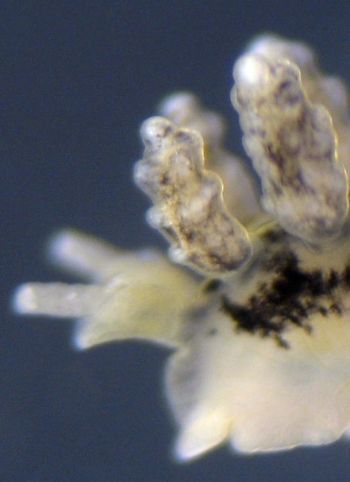
Hi Jeff,
Thanks for a perfect example of this species. We might add that some specimens of Doto columbiana have a thin dark line circling each tubercle on the cerata.
Best wishes,
Dave Behrens
Doto kya from Northern California
August 19, 2006
From: John Albers-Mead
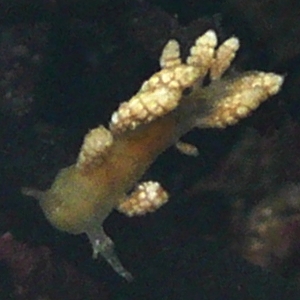
I found this guy in a tide pool at Bean Hollow State Beach in Northern California. He's my first Doto find and I was curious if anyone knew anything more about it.
Locality: Bean Hollow State Beach, 6 cm, California, USA, Pacific, 10 August 2006, Intertidal. Length: ~12 mm. Photographer: John Albers-Mead.
Thanks.
John
nudibranch@jaminc.com
Albers-Mead, J., 2006 (Aug 19) Doto kya from Northern California. [Message in] Sea Slug Forum. Australian Museum, Sydney. Available from http://www.seaslugforum.net/find/17486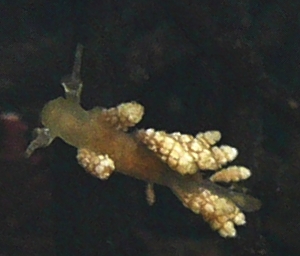
Hi John,
Bean Hollow (aka Arroyo de Freoles) brings back many youthful memories, but no sightings of Doto for me. Species of Doto are very hard to accurately identify from photographs, but because your specimen has a fluted margin on the rhinophoral sheath, and white ceratal cores, I am guessing it is Doto kya Marcus, 1961. Most specimens have brown flecks and blotches on the body.
This species reaches about 10 mm in length and feeds on the hydroids, Abietinaria, Obelia, Plummularia, Sarsia and Eudendrium.
Best wishes,
Dave Behrens
Fact sheet for Doto kya
February 9, 2006
From: Jeff Goddard
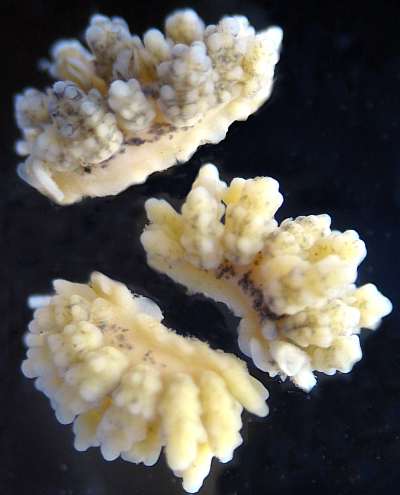
Note added 31 August 2006: The photo here was originally provided by Jeff for the Doto kya Fact Sheet, but later replaced [message #17538 ]. I have kept it here for reference.
Hi Bill,
Here is the Fact sheet for Doto kya. I hope to obtain better photos of the living animals within the next few months.
Bolinas point , Intertidal, California, USA, Pacific, 16 August 2004, Rocky shore. Length: 5.3 mm (preserved). Photographer: Jeff Goddard
Best wishes,
Jeff
goddard@lifesci.ucsb.edu
Goddard, J.H.R., 2006 (Feb 9) Fact sheet for Doto kya. [Message in] Sea Slug Forum. Australian Museum, Sydney. Available from http://www.seaslugforum.net/find/15801Thanks Jeff,
Bill Rudman
Doto kya from Oregon
January 31, 2006
From: Jeff Goddard

Hi Bill,
For comparison with the other NE Pacific species of Doto, here are a few images of Doto kya.
Locality: North Cove, Cape Arago, Oregon, USA. Pacific coast. Intertidal. Length: 10 mm. May 1980. Rocky shore. Photographer: Jeff Goddard
The images, while of poor quality, do show the larger number of cerata, especially compared to Doto columbiana, and also just barely show a few of the opaque white bodies observed in the rhinophores and rhinophore sheaths of this species. The photo of Doto kya in Dave Behrens' Pacific Coast Nudibranchs shows these traits much better, and I hope that someone submits to the Forum a much better photo of this species to replace mine.
Best wishes,
Jeff Goddard
goddard@lifesci.ucsb.edu
Goddard, J.H.R., 2006 (Jan 31) Doto kya from Oregon. [Message in] Sea Slug Forum. Australian Museum, Sydney. Available from http://www.seaslugforum.net/find/15679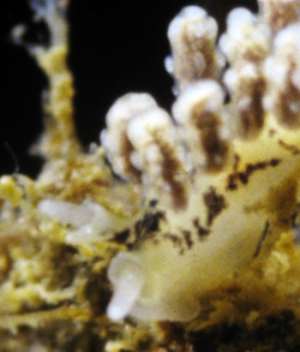
Dear Jeff,
Thanks again for these photos. I hope we are not boring those not interested in Doto from the west coast of Nth America, but it will be very valuable to have these species sorted out.
Best wishes,
Bill Rudman
Doto kya from British Columbia
April 19, 2002
From: Marli Wakeling
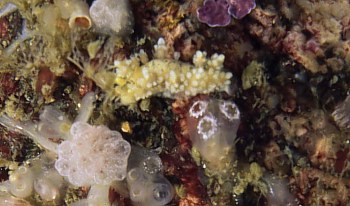
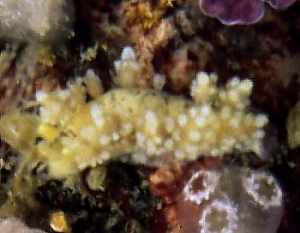
Hi Bill,
Here is what I think is Doto kya. It is very small, only several millimetres in length. It was found at a site near Port Hardy, British Columbia named "Tunicate Bay", where there were many colonial tunicates, named Distaplia occidentalis. Several other Doto species were found at this site; could these tunicates be a food source? I always thought 'Dotos' fed on hydroids.
PHOTO: Tunicate Bay, Port Hardy, British Columbia, Canada
DEPTH: 45 feet
LENGTH: 4mm
DATE: August 12, 2001
PHOTO: Marli Wakeling
Marli
scubamarli@excite.com
Wakeling, M., 2002 (Apr 19) Doto kya from British Columbia. [Message in] Sea Slug Forum. Australian Museum, Sydney. Available from http://www.seaslugforum.net/find/6486Thanks Marli,
I guess anything is possible but I suspect that creeping all over the substrate are microscopic hydroid colonies. As well as the larger more bushy hydroid colonies there are many species which consist of a single stolon or 'root-like' tube which extends across a substrate much like a fungal hypha, giving off single stalks at regular intervals. Often these can only be seen with a binocular microscope - a difficult instrument to use underwater.
I'm afraid I can't make any sensible comment on the identification of these species of Doto. They are definitely the domain of a local expert.
Best wishes,
Bill Rudman
